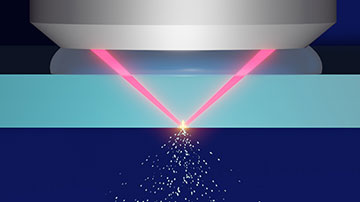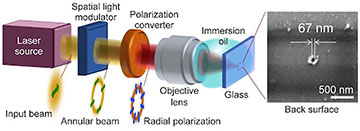
Researchers have focused radially polarized light from a laser to very small spot sizes on the far side of a piece of glass by shaping the beam so that it undergoes total internal reflection, enhancing its longitudinal electric field. [Image: Y. Kozawa et al.]
Scientists in Japan have shown how to improve the precision of laser ablation by using interference to boost the longitudinal electric field of a radially polarized beam (Opt. Lett., doi: 10.1364/OL.517382). They say that the technique, which can produce features less than 100 nanometers across, could have applications in semiconductor manufacturing and medicine.
A smaller focal spot
Laser pulses just a few hundred femtoseconds (10-15 s) long can be used to carve out features as small as a few micrometers across while depositing very little heat. However, modern electronic and biomedical devices are calling for even smaller feature sizes―down to 100 nanometers or less. Reaching those scales is a question of reducing the size of a laser's focal spot, but doing so is generally limited by the wavelength of laser light and the numerical aperture of the lens used to focus the beam.
One way to shrink the spot size is to use beams with radial polarization, which means that the beams’ electric field vectors all point toward their center. Such beams can improve on the resolution of more conventional linearly or circularly polarized light by generating a longitudinal electric field at their focus. Already exploited in one particular form of microscopy, radial polarization might also potentially improve ultrafast laser processing.
One way to shrink the spot size is to use beams with radial polarization, which means that the beams’ electric field vectors all point toward their center.
A major challenge, however, is ensuring a strong enough longitudinal field at the interface between different materials. This strength varies in line with the ratio of the square of the refractive indices of the two materials in question, so can be quite seriously weakened when light passes from air into, say, glass.
Looking to the far side
Yuichi Kozawa and colleagues at Tohoku University have now shown how this problem could be overcome by focusing radially polarized beams onto the far surface of a transparent material from the inside, rather than onto the nearer, outside surface. They also boost longitudinal field strength by exploiting the interference between incoming and reflected waves.
The researchers started by using computer simulations to work out how the intensity of a radially polarized beam's longitudinal field―and hence beam spot size―varies when the beam is brought to a focus by a lens with a high numerical aperture. They found that in air, the intensity should peak at the focus, resulting in a tight circular spot. If the beam was focused on the surface of a glass block, the simulation indicated that the contrast in the refractive index should lower the intensity and yield a doughnut-shaped spot.
However, Kozawa and his team showed that they could restore the small spot size by instead focusing the light on the far side of the glass and placing the lens in oil. Since it has the same refractive index as the glass, the oil would remove the upper interface― eliminating its boundary condition and regaining the longitudinal field intensity.

Fabrication of an ablation crater with a size corresponding to about one-sixteenth of the wavelength by single-shot laser irradiation of the back surface of a glass with an annular-shaped radially polarized beam. [Image: Y. Kozawa et al.]
They confirmed these simulations experimentally by sending roughly 300-fs laser pulses with a wavelength of 1040 nm through a segmented half-wave plate and then focusing them on either the front or back surface of a borosilicate glass plate. Employing three different lenses (and azimuthal light), they found that they generated a circular, as opposed to doughnut-shaped, ablation crater―which measured some 200 nm across―only when using a radially polarized beam and a lens with a numerical aperture of 1.4 to focus the pulses on the back of the glass plate.
Enhancing longitudinal field intensity
In addition, the researchers worked out how to enhance the longitudinal field intensity by maximizing interference between the incident waves and those reflected from the back surface of the glass. As they explain in their paper, this should occur when all of the light is reflected rather than refracted—in other words, when the beam is incident at the critical angle for glass and air. And this, they reasoned, ought to be made possible by shaping the beam profile into a narrow ring to constrain the angle of the incident wave.
They confirmed this idea experimentally by passing laser pulses through a spatial light modulator to create ring shapes with varying parameters, then imparting radial polarization on the pulses and focusing them to the far side of the glass plate. The test showed that the rings' parameters could be altered over a range of values and still generate spot-shaped craters. But it also established that only when those values were close to those needed for the critical angle did the team achieve the smallest spot―just 67 nm across, or about one-sixteenth of the laser light's wavelength.
Kozawa and colleagues argue that these results prove that the size of ablation features can be controlled by manipulating the longitudinal electric field of a radially polarized laser beam.
Kozawa and colleagues argue that these results prove that the size of ablation features can be controlled by manipulating the longitudinal electric field of a radially polarized laser beam. And as a result, they say, the work could potentially “improve the spatial resolution in laser processing, realizing nanometer-scale processes.”
The researchers explain that this idea of exploiting total internal reflection could be applied to a number of existing techniques that involve focusing a laser beam on the far surface of a transparent material. And they add that by changing the laser wavelength, other materials could be targeted―silicon, for example, could be processed using a wavelength of 1100 nm or more.
